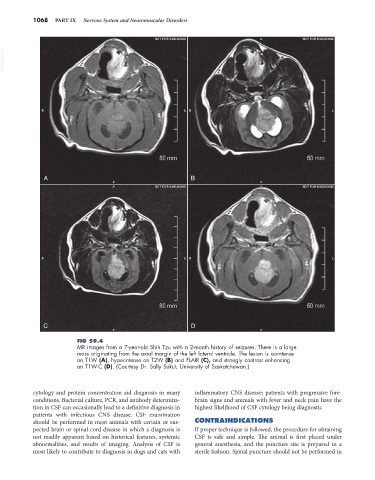Page 1096 - Small Animal Internal Medicine, 6th Edition
P. 1096
1068 PART IX Nervous System and Neuromuscular Disorders
VetBooks.ir
A B
C D
FIG 59.4
MR images from a 7-year-old Shih Tzu with a 2-month history of seizures. There is a large
mass originating from the axial margin of the left lateral ventricle. The lesion is isointense
on T1W (A), hyperintense on T2W (B) and FLAIR (C), and strongly contrast enhancing
on T1W-C (D). (Courtesy Dr. Sally Sukut, University of Saskatchewan.)
cytology and protein concentration aid diagnosis in many inflammatory CNS disease; patients with progressive fore-
conditions. Bacterial culture, PCR, and antibody determina- brain signs and animals with fever and neck pain have the
tion in CSF can occasionally lead to a definitive diagnosis in highest likelihood of CSF cytology being diagnostic.
patients with infectious CNS disease. CSF examination
should be performed in most animals with certain or sus- CONTRAINDICATIONS
pected brain or spinal cord disease in which a diagnosis is If proper technique is followed, the procedure for obtaining
not readily apparent based on historical features, systemic CSF is safe and simple. The animal is first placed under
abnormalities, and results of imaging. Analysis of CSF is general anesthesia, and the puncture site is prepared in a
most likely to contribute to diagnosis in dogs and cats with sterile fashion. Spinal puncture should not be performed in

